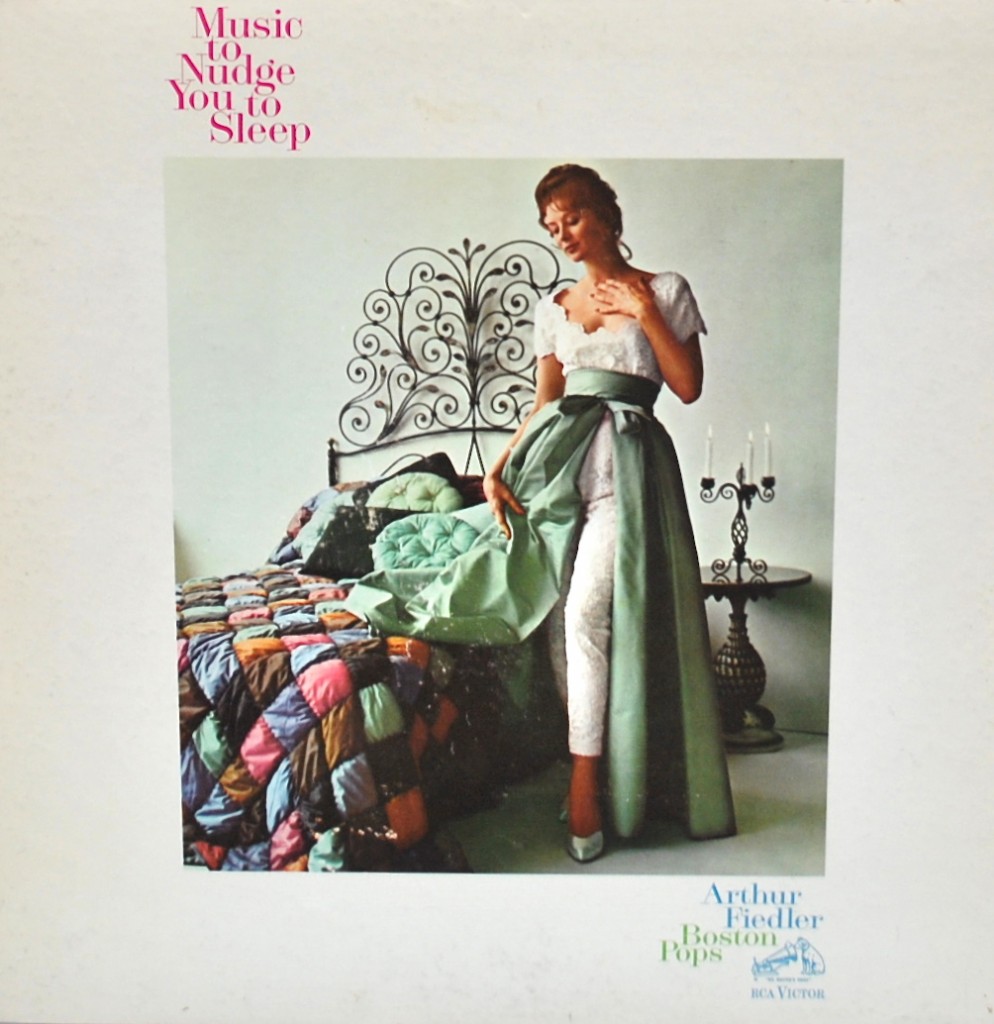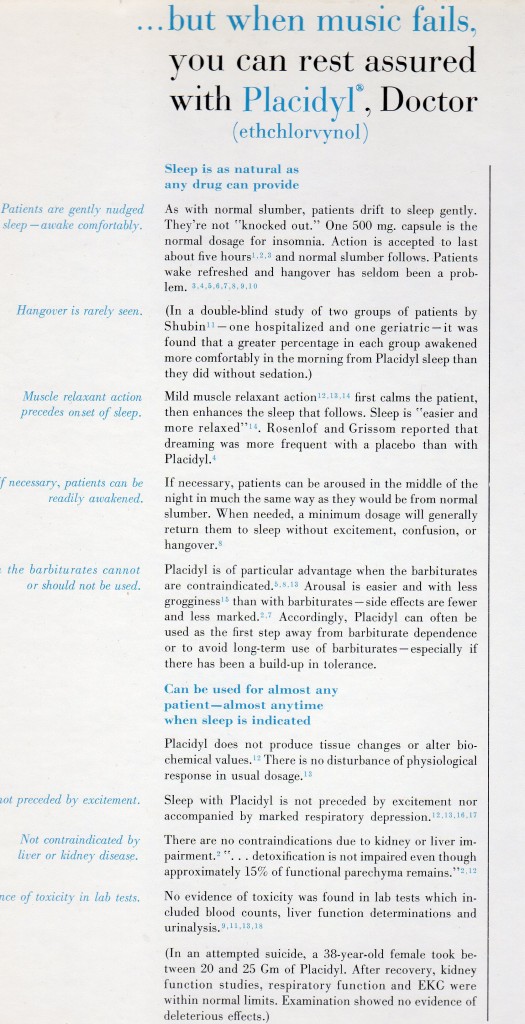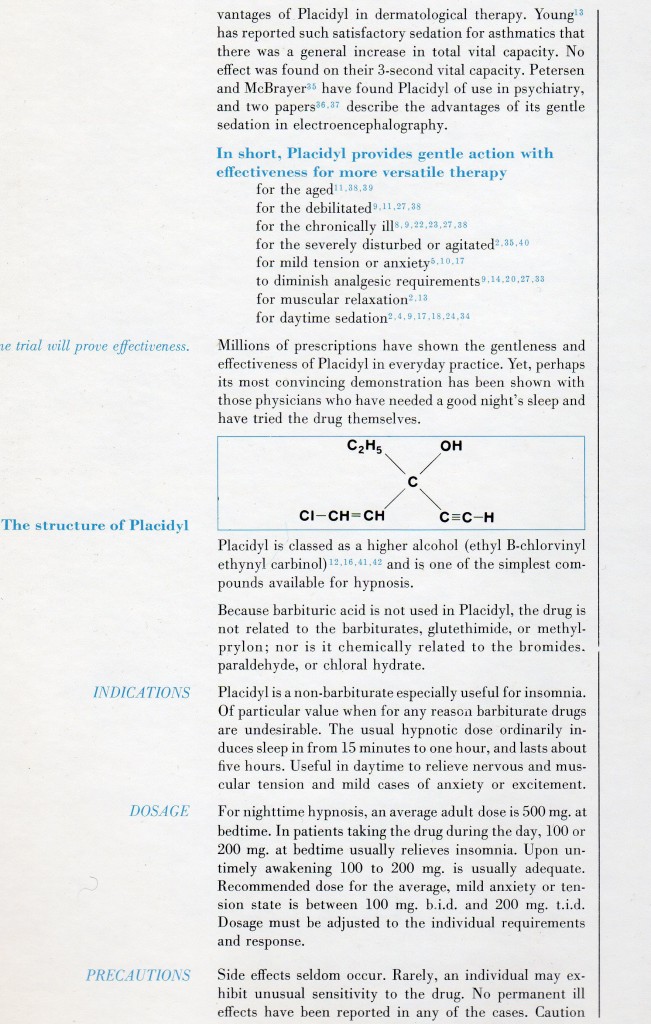The holidays can be stressful. So stressful you lose sleep. Maybe you need Placidyl. This post originally ran February 5, 2013.  Ahh, the 1960s. A simpler time when women wore pant-skirts and insomnia could be cured by the soothing sounds of Liadov’s Musical Snuff Box. Well, not quite. Flip open this album and you’ll find a two-page ad for a sleeping pill called Placidyl. The tagline reads: “But when music fails, you can rest assured with Placidyl, Doctor.”
Ahh, the 1960s. A simpler time when women wore pant-skirts and insomnia could be cured by the soothing sounds of Liadov’s Musical Snuff Box. Well, not quite. Flip open this album and you’ll find a two-page ad for a sleeping pill called Placidyl. The tagline reads: “But when music fails, you can rest assured with Placidyl, Doctor.”
Here’s what I find striking. First, this isn’t an album with a drug ad slapped surreptitiously on the inside cover. The album is the drug ad. That title, “Music to Nudge You to Sleep” — that’s actually Placidyl’s campaign slogan. Drugmaker Abbott Laboratories promised Placidyl would “nudge” patients to sleep in the print ads too. Second, this isn’t some rinky-dink endeavor. The music — ten songs in all — is performed by the Boston Pops led by Arthur Fielder, a man the New York Times called “one of the world’s best-known musical figures.”
The album appears to be the love child of a strange (and brief) affair between the music industry and pharma. A blurb in the April 4, 1964 issue of Billboard Magazine notes that record label RCA Victor “is now leading the way into the ‘Land of Nod.’” (A later album, “Singing the Blues,” plugged a Merck antidepressant called Elavil.)
I found this gem at a yard sale in Brooklyn, and I nearly discarded it. Then I opened the cover to find gold — a wealth of information about Placidyl including a diagram of its chemical structure. The info, packed with study data and references, is clearly aimed at doctors, not consumers. On the Pharmalot site, one commenter notes that such albums were handed out “as swag at doctors conventions in the 1960s.”
Who can benefit from Placidyl? Pretty much anyone, including the aged, the debilitated, the chronically ill, the severely disturbed or agitated, and people with mild anxiety or tension. Even pregant ladies can take Placidyl. In fact, “For eight years now, Placidyl has been safely used during pregnancy. The drug has been part of the anesthetic regimen for Cesarean Section at the Mayo Clinic since 1959,” according to the album’s text.
The insert also notes that Placidyl might be a good way to wean patients off addictive barbiturates. Of course, we now know that Placidyl itself is massively addictive. According to columnist Jack Schafer:
The abuse potential of Placidyl has always been rated as high: An associate professor of psychiatry at Johns Hopkins University told the Post in 1986 that it was “a strong drug I would use only under very exceptional circumstance” and that he wouldn’t give it to people for more than one or two weeks.
Former Chief Justice William Rehnquist fell under Placidyl’s spell in the 1970s. The standard adult dose is 500 milligrams a day. By 1981 Rehnquist was taking 1,500 milligrams, Schafer writes. Perhaps not surprisingly, “he began slurring his speech in public, became tongue-tied while pronouncing long words, and sometimes had trouble finishing his thoughts.”
Placidyl isn’t available in the US anymore. It has been replaced by newer drugs like the blockbuster Ambien (which comes with its own problems). And drug companies no longer commission albums (although some musicians advertise for free). But it’s fun to think about the marketing possibilities. Pharmalot commenter Justice in MI proposes a few killer advertising pairings. My favorite? A match between the Stones’ (I Can’t Get No) Satisfaction and the impotence drug Viagra.
Good article. Another example of what is noted in Eric Topol’s book The Creative Destruction of Medicine.
Drug companies are going to use social media including folks noting how a drug changed their life, to push their products. The feds I believe are getting wise to this ” get around” – Barry Solomon R.Ph M.Ed